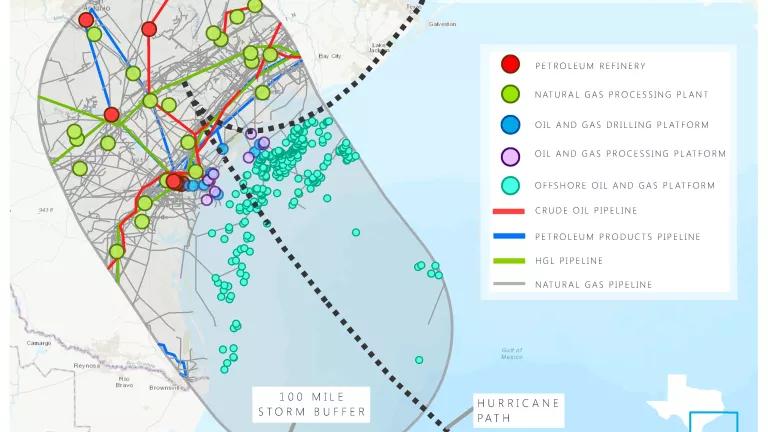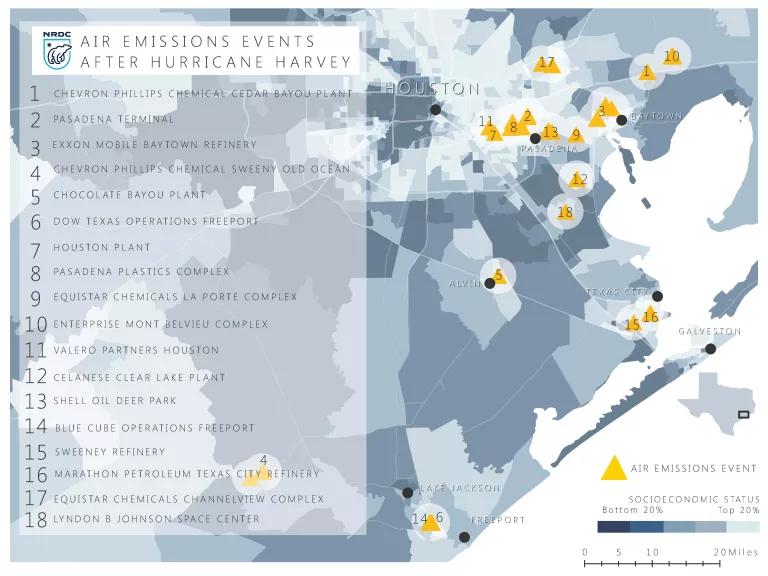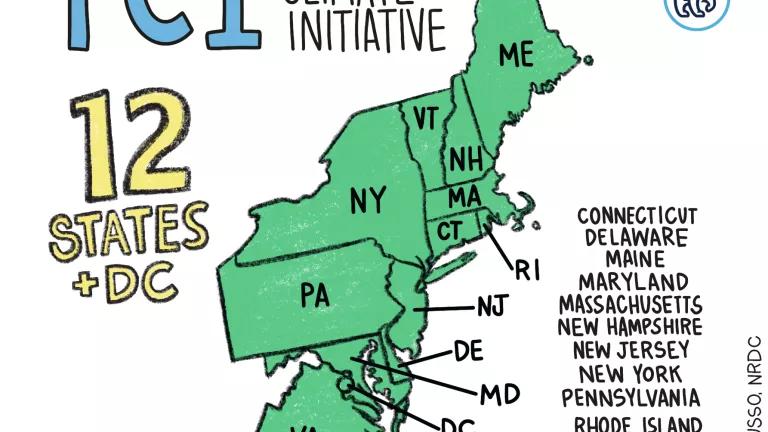Harvey Exposed Oil Issues We Must Address

The catastrophe of Hurricane Harvey is now shedding light on how climate change – manifesting in the form of stronger and more intense weather events – can bring enormous destruction to communities. Because the region hit by Harvey also serves as a home base to much of the country’s oil industry and infrastructure, there is another story to be told about the how the storm is unleashing toxic pollution to land, water, and air. It is too early to tell the full extent of the environmental impact of the hurricane as many of the impacts to the region are still unfolding.
The storm caused the oil industry losses. But we’re learning more and more about damage to industry refineries, petrochemical plants, and transportation infrastructure which also endangers the health of the already-beleaguered population in proximity. We’ve learned of dozens of toxic air emissions events, oil spills, and other instances where oil industry assets released pollution. In the short-term, Harvey should serve as a wake-up call for industry’s need to prepare for more climate-related severe weather. But the storm showed how essential it is for us to move away from a system so reliant on petroleum, both because of local toxic impacts and its contribution to climate change.
On the ground, the concentration of oil processing plants and infrastructure in southeastern Texas has helped add toxic chemical releases to the list of issues residents and evacuees are already facing. Within 100 miles of Harvey’s path as a Category 4 Hurricane, there were 33 oil refineries with the capacity to process a total of 1,926 million barrels of oil per day, 2,751 miles of crude oil pipeline, and 1,443 offshore oil and gas platforms. Too much of it failed to fully withstand the extreme conditions faced during Harvey. And when oil infrastructure fails, human health and the environment are put at risk.
Government officials and the news media made dozens early reports of instances where the hurricane has allowed toxic pollution to be released into the air and flood waters. Houston residents had complained of an “unbearable” chemical smell and almost three dozen air emission event reports by 18 facilities precipitated by Harvey have been submitted to the Texas Commission on Environmental Quality (TCEQ). An air emission event is an instance in which refineries, chemical manufacturing plants, or other facilities have released more air pollution than they’re permitted.

In some cases, companies opted to “flare” gases. Flaring is intended to be used by refineries as an escape valve when internal systems fail. In a well-designed and operated refinery, the process gases are recycled back into the refinery to power it. However, when a refinery has to abruptly and unexpectedly shut down, or sometimes as the result of a malfunction, there are excess process gases that have to be disposed of quickly. In those cases, the gases are flared, which sends hazardous pollutants into the atmosphere.
Other facilities released pollution after taking damage from the storm. A set of ExxonMobil refineries leaked hazardous gases; one after the floating roof of a storage tank partially sank under Harvey’s heavy rains, while the other saw damage to a component that captures sulfur dioxide emissions. The latter of those refineries has also released oil onto a nearby road. A set of tanks damaged by the storm spilled 30,000 gallons of crude oil—a harmful release that we can only hope will be unique. And Skytruth, through analysis of recent satellite imagery, was able to identify onshore a handful of fracking sites where stored chemicals likely escaped into floodwaters, including one just 400 yards from a home. Fracking wastewater poses a variety of health risks to humans, including the ability to cause reproductive and developmental health problems.
Much of the pollution coming from oil industry facilities and infrastructure is toxic. Benzene, a carcinogen, was among the most common released into the air during Harvey, per TCEQ reports. But there are others that are known to be severely irritating to human respiratory and nervous systems released across the city. Similarly, the flood water has become, the New York Times described, “a sea of health and environmental hazards,” with a huge range of pollutants from oil infrastructure, superfund sites, and sewage.
It’s worth noting, however, that Hurricane Harvey’s impacts are not limited to the area touched by the storm. As described above, Southeastern Texas is the center of the oil industry’s refining and transportation infrastructure. The concentration of oil industry facilities is so high, in fact, that the Harvey-induced closure of oil refineries has reduced the United States’ total oil refining capacity by 24 percent at the worst point. Needless to say, the closures have started sending gasoline prices upward across the country. The shutdown of the Colonial Pipeline, which carries diesel and jet fuel from Houston to New York—40 percent of the South’s gasoline—doesn’t help matters. Where consumers and businesses need stability, the oil industry can only offer price volatility.
Hurricane Harvey will likely be counted among the worst natural disasters of our time. If policy makers truly want to address the underlying problem of climate change which creates these more intense storms—reducing oil production would be a great place to start.
We should continue pursuing policies to push higher automotive fuel efficiency, which reduces transportation sector emissions and buffers consumers against gas pump price volatility. Supporting a transition to electric vehicles through tax incentives and investment in EV infrastructure would go further, especially as our electric sector undertakes a parallel clean-energy revolution. And smart infrastructure planning can motivate citizens, particularly in urban areas, to take advantage of efficient public transportation options, walk, and/or bike more often. By reducing our dependence on oil, we can reduce the congestion of oil infrastructure in areas like southeastern Texas, where it will continue to threaten the health of Americans. Unfortunately, President Trump’s administration is working to curtail these very solutions.
There’s a process lesson here, too. President Trump’s administration has made regulatory rollbacks and the fast-tracking of energy and infrastructure projects a priority. But the President should think twice before attacking safeguards, like the Chemical Disaster Rule his EPA is delaying, put in place to protect Americans. And as he pursues a transportation bill, one of his legislative priorities, he should consider how it could be used to, among other things, shore up vulnerable infrastructure that places our communities and environment at risk.
Hurricane Harvey was worse than a worst-case scenario. But, as Times columnist David Leonhardt put it, “the severity of Harvey…is almost certainly related to climate change,” which means the United States could see more storms like it. Hopefully we can use this experience to better prepare our systems for the next one.



